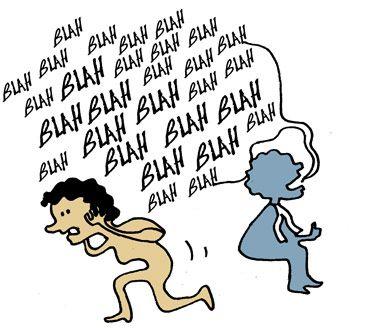 | « Back to article | Print this article |
13 must-follow etiquettes in spoken communication
Continuing with the series of etiquettes in communication, language expert Preeti Shirodkar tells us about what we need to keep in mind while communicating verbally.
Oral communication can be plagued by many barriers, though it constitutes a very common form of communication.
These can include the tone, pitch, accent and pace and more importantly the lack of a reference point, which the audience can go back to at a later point (unless of course the conversation has been recorded).
Though completely ironing out the barriers may not always be possible, a little bit of care and courtesy can go a long way in facilitating the process.
One can reduce the issues that affect oral communication by being aware of and working on the following areas:
Awareness of the audience
The content and vocabulary used need to be tempered to suit the target audience. While a simple vocabulary may become simplistic for an audience well versed with the subject, vocabulary loaded with jargon (extremely technical vocabulary) can well serve to alienate the average receiver. It is therefore important to choose vocabulary as per the large section of the audience that one is covering.
Moreover, one needs to also be careful not to alienate audience of a particular gender, age group or community.
For example, if the reference is constantly to 'he', the women in the audience may get alienated.
Structuring the content
Very often while delivering a speech/interacting with others face to face or through a medium, one tends to take many things for granted. This leads to gaps in communication, which becomes difficult for the listener(s) to bridge.
So too, if one's ideas are not logically ordered and if one moves back and forth in the content, one may put off the listener, make him/her lose out on important aspects or make the person lose a sense of connectivity.
Clarity
The content as well as the pace, tone and accent should be clear. If the speaker lacks clarity about the matter or its organisation, it is most likely to confuse the listener even further.
As regards the latter, though one need not have a 'UK/US' accent, one can neutralise one's accent or then reduce the pace or spell important words, to avoid miscommunication; also, one can place important aspects strategically, in oral communication, and repeat them to reinforce their value.
Be precise
The content as well as the time taken to cover what one desires to say needs to be precise, as diversions can create irritation among the audience. The ability to edit on the spot also helps at such points, as if, one is exceeding the time limit or if the session needs to be cut short, due to a variety of reasons, for which one needs to cultivate the ability to engage in spot editing.
Importance of creativity
The same matter, interestingly expressed, both as regards the content and variations in tone and pitch, can go a long way in creating a great deal of interest in the audience.
An apt illustration is the interest aroused by narrators of stories and comedians, who can keep the audience enrapt for a great deal of time.
Using illustrations, anecdotes, humour and facts and figures
Pure technical communication can get very boring, especially if it is stretched over a long span of time. At such times, illustrations can serve both to enhance the meaning of the content and offer respite to the audience, increasing both their interest and focus.
Knowledge about the medium its use and suitability
Every medium, though available, may not be suitable for each type of communication.
If one is communicating something that would get value added, if one were to be able to witness the response (even if non verbal) of the receiver, it might be better to engage in face-to-face communication rather than using the telephone.
Moreover, it is important to be aware of the etiquettes of the medium, to make effective use of it. For one saying 'hanh' over the phone instead of 'pardon' or 'could you please repeat yourself?' sounds rude.
Tone, pitch, pace
Though aspects that accompany communication, one's tone, pitch and pace can go very far in adding value to or marring communication.
One therefore needs to be aware of these factors and modulate them. In fact these areas can be enhanced by consciously working on them over time. For example, screeching into the mike can prove very irritating for the listener.
So too, a heavy accent, coupled with great speed, can garble communication. Slowing down, a simple measure to adopt, can help add considerable value to the communication.
Repetition as a tool
While excessive repetition could serve to bore the audience; repetition, discreetly used, can serve to emphasise a point or help someone, who has missed out on something, to grasp it. This is the primary reason why headlines are repeated both in radio and television news.
Avoiding categorical/opinionated points of view
Unless there is adequate reason to be so, one should avoid being unnecessarily opinionated or judgemental, as the point of view one is proposing may be open to debate or may change in the light of further evidence, as can be seen in the context of some scientific theories, including one that argued that the earth is flat. It is thus preferable to use phrases like 'on the basis of the facts it can be surmised that' or 'I would like to believe that'. So too, statements that are gender, age or community insensitive should be avoided.
Avoiding excessive use of jargon
Though technical vocabulary is essential, as a knowledge sharing device and a means of making communication more precise, one needs to moderate the use of jargon, as per the audience.
If the audience largely comprises members of the same area of expertise, one can use jargon liberally; however, if the audience is made up of the general public, jargon might serve only to alienate or confuse the listener.
For example, while speaking about the features of an air conditioner to people from an engineering background, a speaker could use technical vocabulary, but while speaking to a general audience, the same features need to be explained in simple terms, which the audience would understand/relate to.
Sensitivity to the audience
One needs to be receptive to the non-verbal cues of the audience and temper one's communication accordingly.
If the audience is looking confused or bored, rather than carrying on in the same manner, one can modulate the content/tone of the communication, in order to make it more effective.
Tempering the content as per the level of formality
The content, vocabulary as well as illustrations need to be chosen, as per the level of formality both of the situation and the relationship between the communicator and the receiver/audience.
For example, certain words like 'guys' make work well in a semi formal situation, even while addressing the audience, but in a formal meeting especially with people, who are much senior in age or position, it might create an impression about the communicator being casual.
In this light, it is worth reflecting upon the words of Doug Firebaugh, though they may sound implausible on the surface, 'Communication is really all anyone ever gets paid for ultimately...and if you cannot effectively communicate...you will pay...not get paid...'













